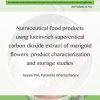DOI 10.17470/NF-016-1041-4
Ganiyu Oboh, Olasunkanmi S. Omojokun, Sunday I. Oyeleye, Ayodele J. Akinyemi
In recent times, the consumption of apples has been encouraged for the management of chronic diseases such as diabetes, but biochemical evidence to support this practice is lacking. Therefore, this study investigated α-amylase and α-glucosidase inhibitory activity, 1,1-diphenyl-2-picrylhydrazyl (DPPH) radical scavenging ability, Fe2+-induced lipid peroxidation potential as well as the total phenol and flavonoid contents of aqueous extracts of the apple varieties Malus sylvestris (green apple), Malus pumila (red apple) and Syzygium samarangense (wax apple). The results showed that all apple varieties inhibited α-amylase (IC50=12.66–16.98 μg/ml) and α-glucosidase (13.55–16.23 μg/ml) in a dosedependent manner, with green apple showing the highest inhibitory activity while wax apple had the least. Similarly, all apple varieties showed dose-dependent DPPH radical scavenging activity (EC50=222.92–278.71 μg/ml) with green apple also showing the highest scavenging activity while wax apple showed the least. Furthermore, the aqueous extracts of the apple varieties dosedependently inhibited Fe2+-induced lipid peroxidation in rat pancreas (38.60–53.57 μg/ml), with wax apple exhibiting the highest inhibitory potential. Also, the total phenol content of the apple varieties ranged from 16.14 to 17.45 mg GAE/100 g, while the flavonoid content ranged from 4.17 to 5.56 mg QUE/100 g, with green apple having the highest total phenolic and flavonoid contents. The biological activities exhibited by the apple varieties could be attributed to the presence of biologically active photochemicals. Furthermore, the apple variety (green apple) with the highest phenolic content showed the best overall activity, indicating the potent role of phenolic compounds in the management of diabetes, thereby providing biochemical support for the use of apples as a functional food in diabetes management.




